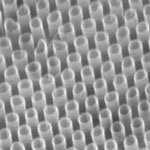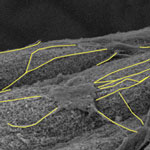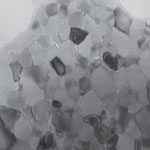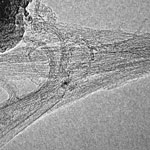Showing Spotlights 65 - 72 of 319 in category All (newest first):
 Materials engineers are keen to exploit the outstanding mechanical properties of carbon nanotubes (CNTs) for applications in fibers, composites, fabrics and other larger-scale structures and devices. The ability to fabricate continuous, multifunctional yarns represents an important step in this direction. The development of a continuous, weavable multilayered CNT yarn with superior mechanical, structural, surface, and electrical properties would open the way for a wide range of structural and functional applications, including composites, intelligent fabrics, catalyst supports, and sensors. Researchers in China have now found that carbon nanotubes can be self-assembled into a stable double-helix structure by a controlled over-twisting process, and this novel structure has unique mechanical properties.
Materials engineers are keen to exploit the outstanding mechanical properties of carbon nanotubes (CNTs) for applications in fibers, composites, fabrics and other larger-scale structures and devices. The ability to fabricate continuous, multifunctional yarns represents an important step in this direction. The development of a continuous, weavable multilayered CNT yarn with superior mechanical, structural, surface, and electrical properties would open the way for a wide range of structural and functional applications, including composites, intelligent fabrics, catalyst supports, and sensors. Researchers in China have now found that carbon nanotubes can be self-assembled into a stable double-helix structure by a controlled over-twisting process, and this novel structure has unique mechanical properties.
Jan 22nd, 2013
 The ideal drug carrier may be something out of science fiction. In principle, it is injected into the body and transports itself to the correct target, such as a tumor, and delivers the required dose at this target. This idealized concept was first proposed by Paul Ehrlich at the beginning of the 20th century and was nicknamed the 'magic bullet' concept. With the advent of nanotechnology and nanomedicine this dream is rapidly becoming a reality. Researchers have already demonstrated that unctionalized carbon nanotubes (CNTs) might be able to target specific cells, become ingested, and then release their contents in response to a chemical trigger. A group of researchers has now essentially achieved this goal. They have encapsulated drugs inside carbon nanotubes for drug delivery and shown that these drugs can be released 'on command' by inductive heating with an external alternating current or pulsed magnetic field.
The ideal drug carrier may be something out of science fiction. In principle, it is injected into the body and transports itself to the correct target, such as a tumor, and delivers the required dose at this target. This idealized concept was first proposed by Paul Ehrlich at the beginning of the 20th century and was nicknamed the 'magic bullet' concept. With the advent of nanotechnology and nanomedicine this dream is rapidly becoming a reality. Researchers have already demonstrated that unctionalized carbon nanotubes (CNTs) might be able to target specific cells, become ingested, and then release their contents in response to a chemical trigger. A group of researchers has now essentially achieved this goal. They have encapsulated drugs inside carbon nanotubes for drug delivery and shown that these drugs can be released 'on command' by inductive heating with an external alternating current or pulsed magnetic field.
Oct 30th, 2012
 Nitrogen-doped carbon nanotubes (CNTs) have been extensively investigated for fuel cell applications due to their excellent electrocatalytic properties. However, their biomedical applications were comparatively less investigated despite reports of their better biocompatibility. When considering carbon nanotubes for drug delivery applications, it is desirable to develop strategies that allow utilize their hollow inner cavities for maximum loading capacity. Small size and facile surface modification are also preferable with regard to their biomedical compatibility. Nitrogen-doped CNTs have been already previously demonstrated to have better biocompatibility and mitigated cytotoxicity as compared to traditional undoped pristine CNTs. Taking advantage of this, researchers used nitrogen doping of CNTs which resulted in formation of cup-shaped compartments in CNTs uniquely suitable for encapsulation. The resulting nitrogen-doped carbon nanotube cups can be corked by gold nanoparticles to form enclosed nanocapsules.
Nitrogen-doped carbon nanotubes (CNTs) have been extensively investigated for fuel cell applications due to their excellent electrocatalytic properties. However, their biomedical applications were comparatively less investigated despite reports of their better biocompatibility. When considering carbon nanotubes for drug delivery applications, it is desirable to develop strategies that allow utilize their hollow inner cavities for maximum loading capacity. Small size and facile surface modification are also preferable with regard to their biomedical compatibility. Nitrogen-doped CNTs have been already previously demonstrated to have better biocompatibility and mitigated cytotoxicity as compared to traditional undoped pristine CNTs. Taking advantage of this, researchers used nitrogen doping of CNTs which resulted in formation of cup-shaped compartments in CNTs uniquely suitable for encapsulation. The resulting nitrogen-doped carbon nanotube cups can be corked by gold nanoparticles to form enclosed nanocapsules.
Aug 2nd, 2012
 Carbon nanotubes, like the nervous cells of our brain, are excellent electrical signal conductors and can form intimate mechanical contacts with cellular membranes, thereby establishing a functional link to neuronal structures. There is a growing body of research on using nanomaterials in neural engineering. This emerging field of 'nanoneuroscience' explores and utilizes the potential of carbon nanotubes (CNTs) for fabricating durable, robust substrates, scaffolds and interfacing devices that change how researchers approach neuroscience. One area of neuron-CNT interaction that is now being probed is the effect of CNTs on neural stem cells. In new work by a team of scientists from Taiwan, it was found that electrical stimulation significantly promotes the early differentiation and maturation of neural stem cells.
Carbon nanotubes, like the nervous cells of our brain, are excellent electrical signal conductors and can form intimate mechanical contacts with cellular membranes, thereby establishing a functional link to neuronal structures. There is a growing body of research on using nanomaterials in neural engineering. This emerging field of 'nanoneuroscience' explores and utilizes the potential of carbon nanotubes (CNTs) for fabricating durable, robust substrates, scaffolds and interfacing devices that change how researchers approach neuroscience. One area of neuron-CNT interaction that is now being probed is the effect of CNTs on neural stem cells. In new work by a team of scientists from Taiwan, it was found that electrical stimulation significantly promotes the early differentiation and maturation of neural stem cells.
Jul 23rd, 2012
 In recent years, there has been growing interest, and progress, in the design and fabrication of carbon nanotube (CNT) macrostructures for effective utilization of their remarkable properties at the macroscale. Realization of such highly concentrated CNT macrostructures in a stiff/elastic environment able to impose compression on individual CNTs and CNT/CNT junctions, could dramatically improve their network connectivity, transport property, and durability, and perhaps lead to novel organic/inorganic hybrids with unprecedented multifunctional properties. In a new study, researchers have effectively addressed this challenge and proposed a new concept - a highly concentrated, 3D macrostructure of individual multiwalled CNTs in a ceramic environment - that dramatically improves not only the transport property and network connectivity of the MWCNT 3D macrostructure but also the strain tolerance of the ceramic material.
In recent years, there has been growing interest, and progress, in the design and fabrication of carbon nanotube (CNT) macrostructures for effective utilization of their remarkable properties at the macroscale. Realization of such highly concentrated CNT macrostructures in a stiff/elastic environment able to impose compression on individual CNTs and CNT/CNT junctions, could dramatically improve their network connectivity, transport property, and durability, and perhaps lead to novel organic/inorganic hybrids with unprecedented multifunctional properties. In a new study, researchers have effectively addressed this challenge and proposed a new concept - a highly concentrated, 3D macrostructure of individual multiwalled CNTs in a ceramic environment - that dramatically improves not only the transport property and network connectivity of the MWCNT 3D macrostructure but also the strain tolerance of the ceramic material.
Jul 17th, 2012
 Carbon nanotubes (CNTs) show extraordinary multifunctionality, including excellent mechanical, electrical and thermal properties. To be used in practical applications, the CNTs need to be assembled into macroscale structures such as films, fibers and composites. Unfortunately, so far the properties of these macro-structures have been very poor, usually one to three orders of magnitude lower than that of individual CNTs. Low CNT structural perfection, alignment and intertube interaction are key issues that are responsible for such disappointing properties. Researchers have now demonstrated a simple, efficient and scalable strategy to make CNT films ultra-strong and conductive, in which the CNTs are well aligned and densely packed by exploiting drawable CNT arrays as precursors.
Carbon nanotubes (CNTs) show extraordinary multifunctionality, including excellent mechanical, electrical and thermal properties. To be used in practical applications, the CNTs need to be assembled into macroscale structures such as films, fibers and composites. Unfortunately, so far the properties of these macro-structures have been very poor, usually one to three orders of magnitude lower than that of individual CNTs. Low CNT structural perfection, alignment and intertube interaction are key issues that are responsible for such disappointing properties. Researchers have now demonstrated a simple, efficient and scalable strategy to make CNT films ultra-strong and conductive, in which the CNTs are well aligned and densely packed by exploiting drawable CNT arrays as precursors.
Jun 8th, 2012
 Nanofluids - engineered colloidal suspensions of nanoparticles in a base fluid - are attracting a great deal of interest with their enormous potential to provide enhanced performance properties. Particularly with respect to heat transfer, and compared with more conventional heat transfer fluids (i.e. coolants) currently available, nanofluidic coolants exhibit enhanced thermal conductivity. Attempts to increase the thermal conductivity of heat transfer fluids using nanoparticles has been an active research area over the past decade. However, these attempts have not resulted in a significant improvement in conductivity due to the low thermal conductivity of nanoparticles and high thermal boundary resistance around the 0-dimensional nanoparticles. Researchers have therefore decided to produce a nanofluid using single-walled carbon nanotubes because of their much higher thermal conductivity and their ability to form connected networks with the neighboring carbon nanotubes, thereby increasing the heat transfer path.
Nanofluids - engineered colloidal suspensions of nanoparticles in a base fluid - are attracting a great deal of interest with their enormous potential to provide enhanced performance properties. Particularly with respect to heat transfer, and compared with more conventional heat transfer fluids (i.e. coolants) currently available, nanofluidic coolants exhibit enhanced thermal conductivity. Attempts to increase the thermal conductivity of heat transfer fluids using nanoparticles has been an active research area over the past decade. However, these attempts have not resulted in a significant improvement in conductivity due to the low thermal conductivity of nanoparticles and high thermal boundary resistance around the 0-dimensional nanoparticles. Researchers have therefore decided to produce a nanofluid using single-walled carbon nanotubes because of their much higher thermal conductivity and their ability to form connected networks with the neighboring carbon nanotubes, thereby increasing the heat transfer path.
May 11th, 2012
 Commercially available supercapacitors store energy in two closely spaced layers with opposing charges and offer fast charge/discharge rates and the ability to sustain millions of cycles. Researchers have come up with various electrode materials to improve the performance of supercapacitors, focussing mostly on porous carbon due to its high surface areas, tunable structures, good conductivities, and low cost. Researchers at KAUST now have developed novel supercapacitor electrodes with remarkable pseudocapacitance. They used a scheme of current collector dependent self-organization of mesoporous cobalt oxide nanowires has been used to create unique supercapacitor electrodes, with each nanowire making direct contact with the current collector.
Commercially available supercapacitors store energy in two closely spaced layers with opposing charges and offer fast charge/discharge rates and the ability to sustain millions of cycles. Researchers have come up with various electrode materials to improve the performance of supercapacitors, focussing mostly on porous carbon due to its high surface areas, tunable structures, good conductivities, and low cost. Researchers at KAUST now have developed novel supercapacitor electrodes with remarkable pseudocapacitance. They used a scheme of current collector dependent self-organization of mesoporous cobalt oxide nanowires has been used to create unique supercapacitor electrodes, with each nanowire making direct contact with the current collector.
Apr 30th, 2012
 Materials engineers are keen to exploit the outstanding mechanical properties of carbon nanotubes (CNTs) for applications in fibers, composites, fabrics and other larger-scale structures and devices. The ability to fabricate continuous, multifunctional yarns represents an important step in this direction. The development of a continuous, weavable multilayered CNT yarn with superior mechanical, structural, surface, and electrical properties would open the way for a wide range of structural and functional applications, including composites, intelligent fabrics, catalyst supports, and sensors. Researchers in China have now found that carbon nanotubes can be self-assembled into a stable double-helix structure by a controlled over-twisting process, and this novel structure has unique mechanical properties.
Materials engineers are keen to exploit the outstanding mechanical properties of carbon nanotubes (CNTs) for applications in fibers, composites, fabrics and other larger-scale structures and devices. The ability to fabricate continuous, multifunctional yarns represents an important step in this direction. The development of a continuous, weavable multilayered CNT yarn with superior mechanical, structural, surface, and electrical properties would open the way for a wide range of structural and functional applications, including composites, intelligent fabrics, catalyst supports, and sensors. Researchers in China have now found that carbon nanotubes can be self-assembled into a stable double-helix structure by a controlled over-twisting process, and this novel structure has unique mechanical properties.
 Subscribe to our Nanotechnology Spotlight feed
Subscribe to our Nanotechnology Spotlight feed





